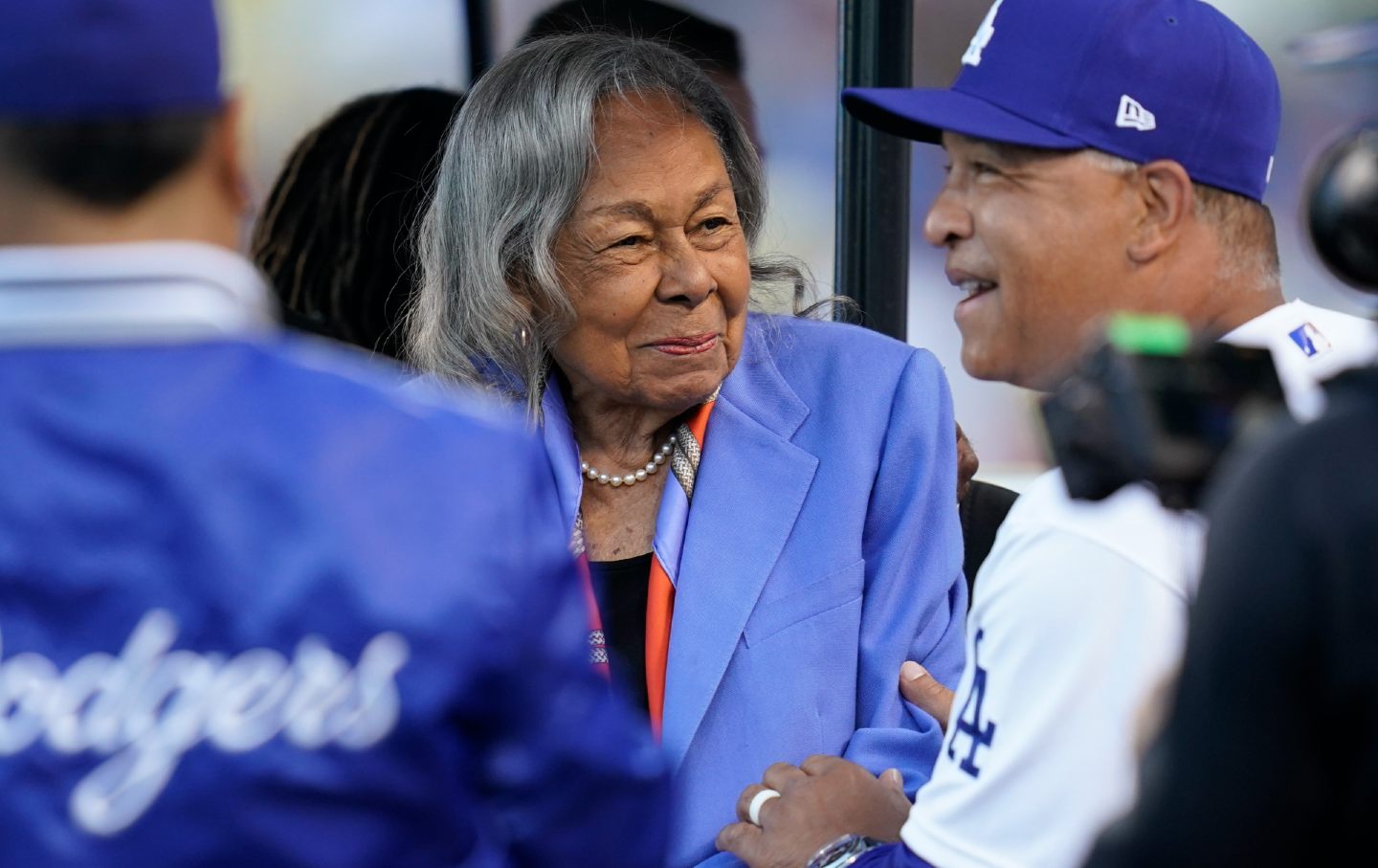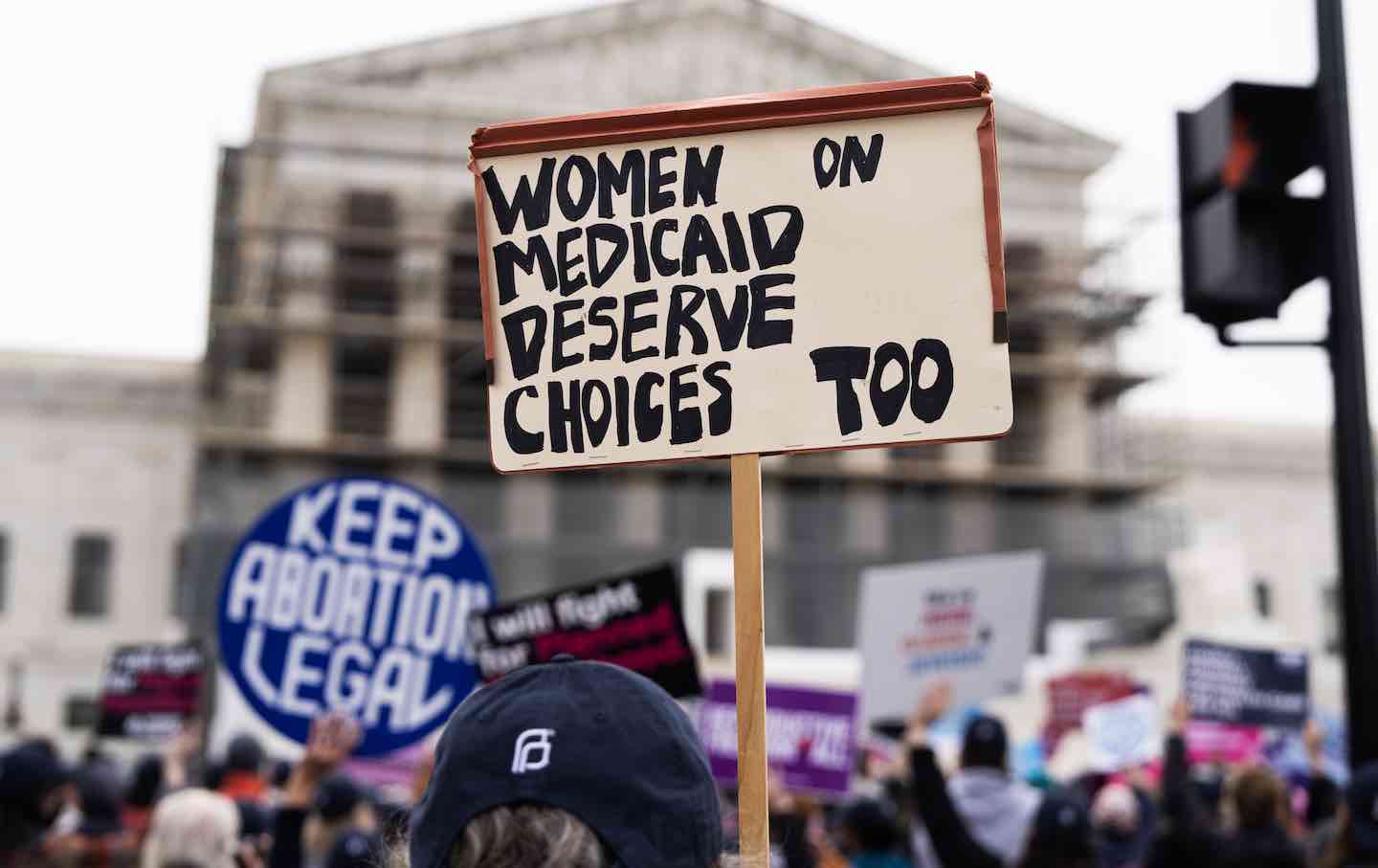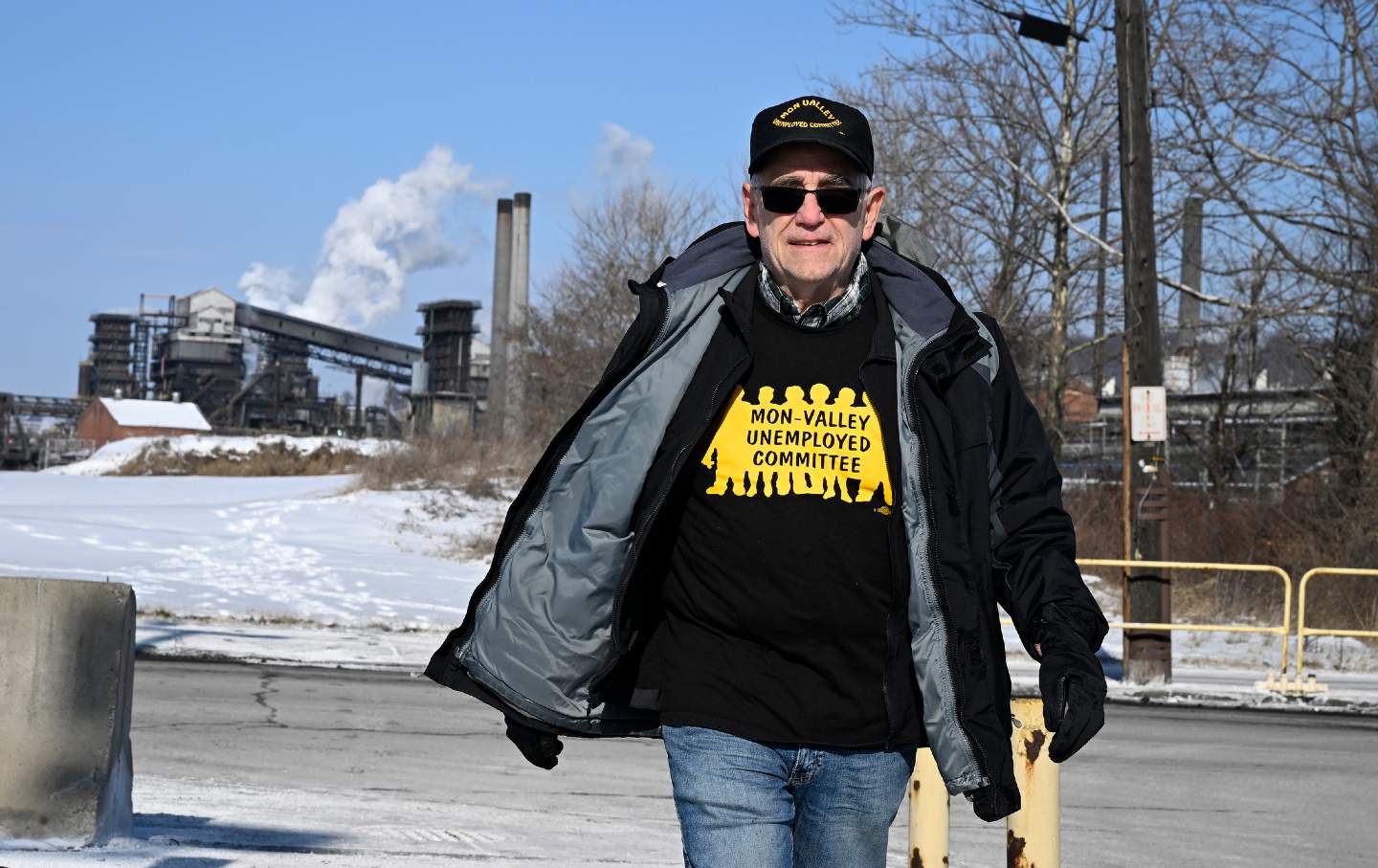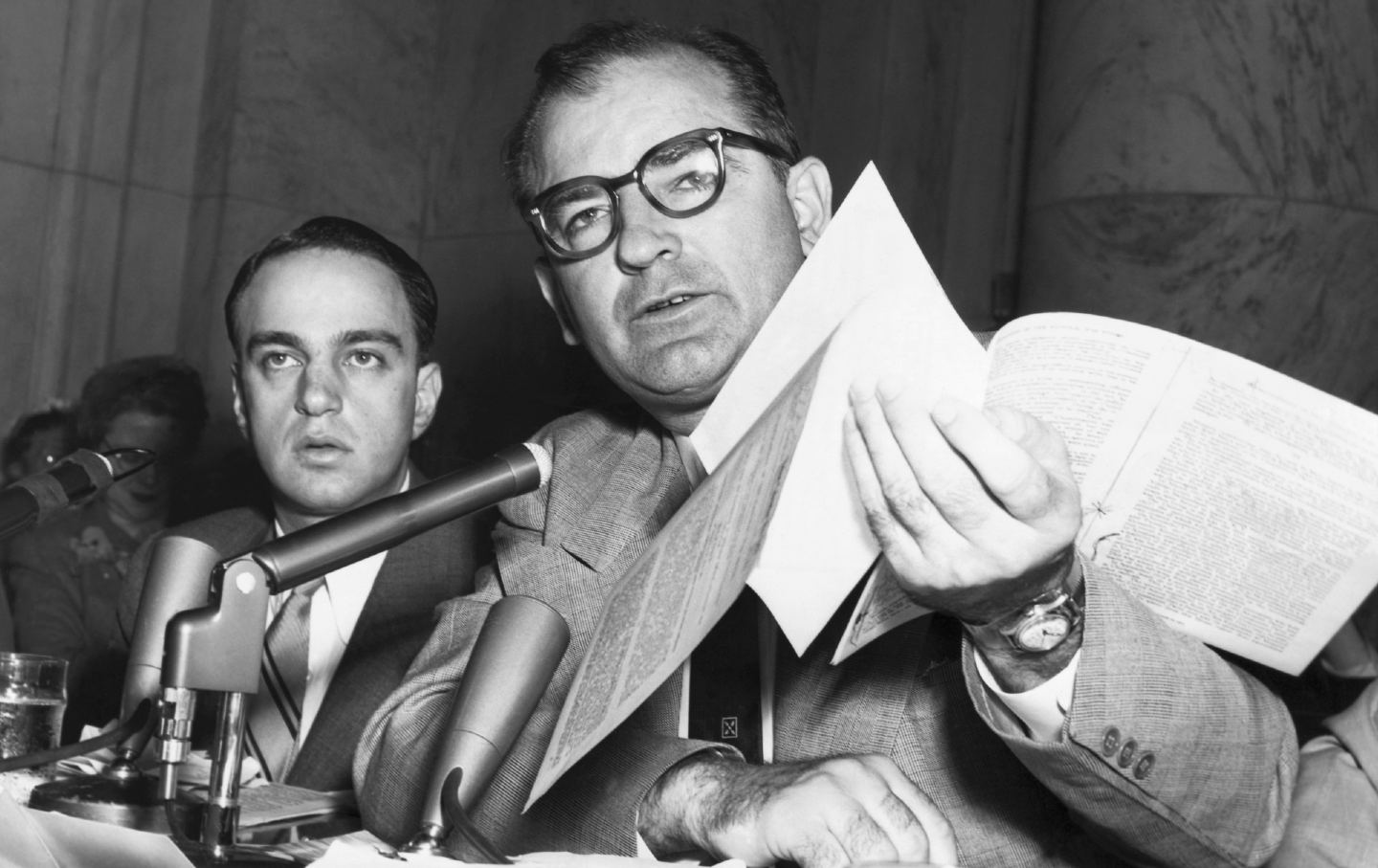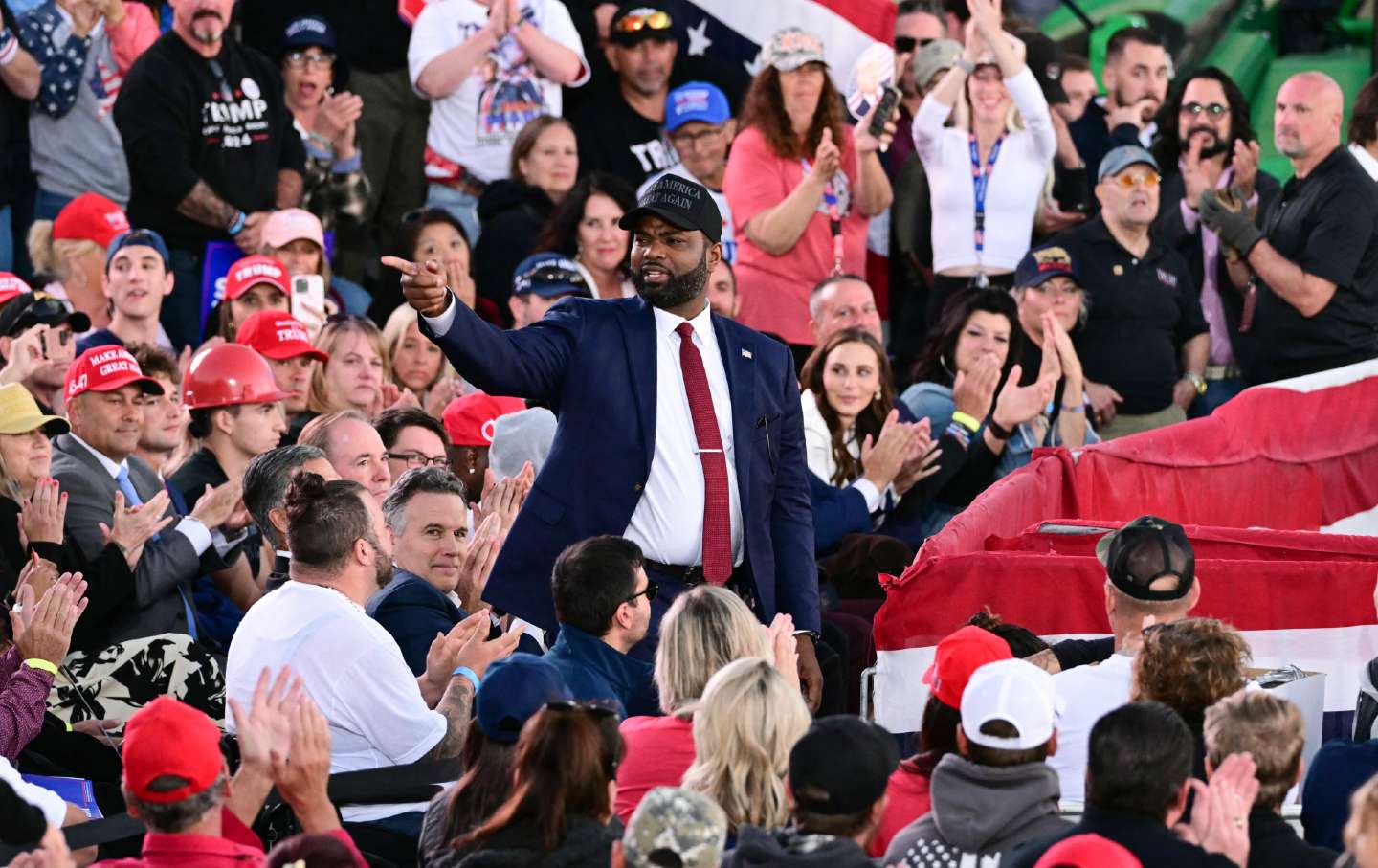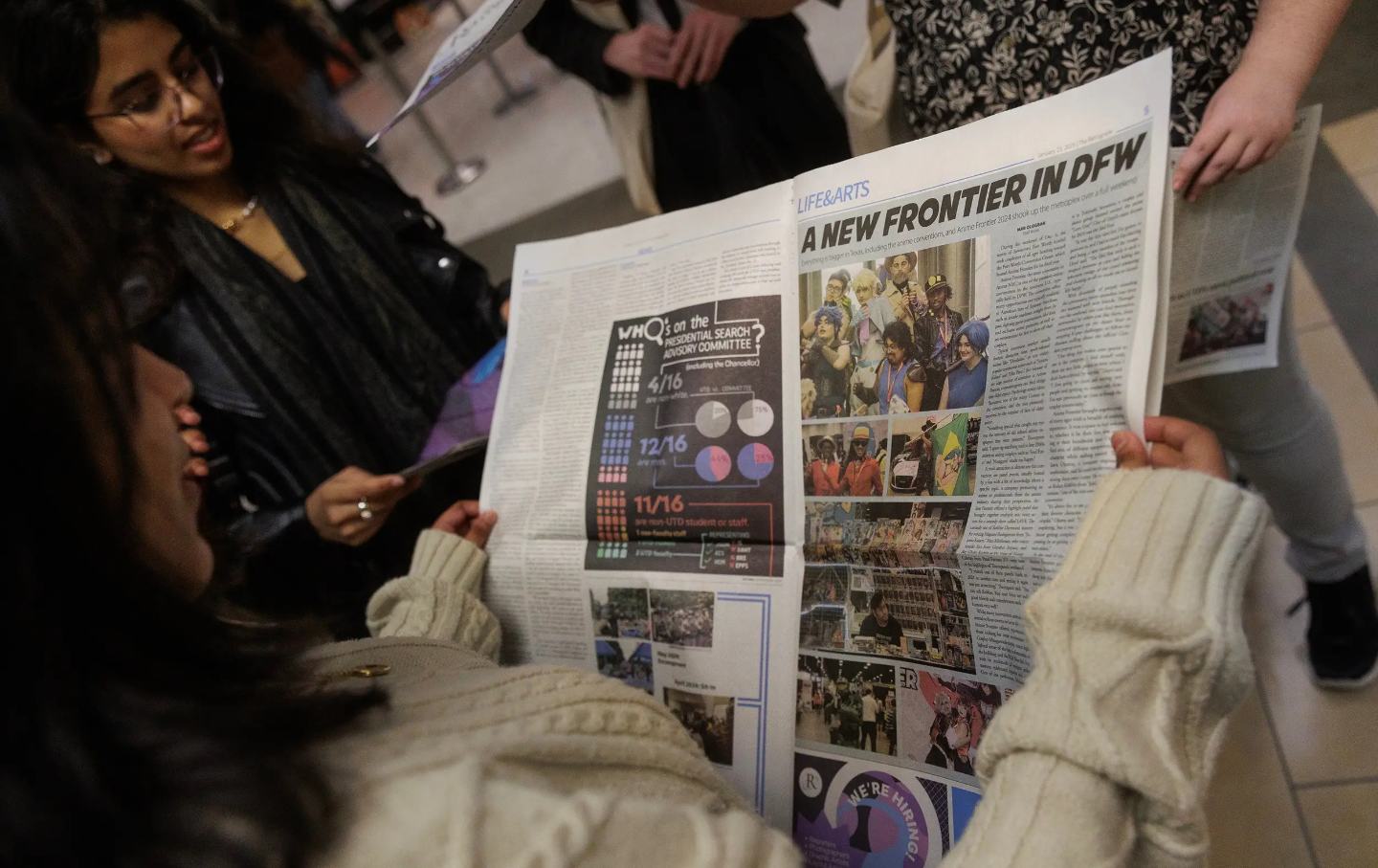Is Trump Building an Army of Modern Blackshirts?
The proliferation of pro-Trump militia groups across the country eerily echoes the rise of Hitler’s SA and Mussolini’s squadristi.
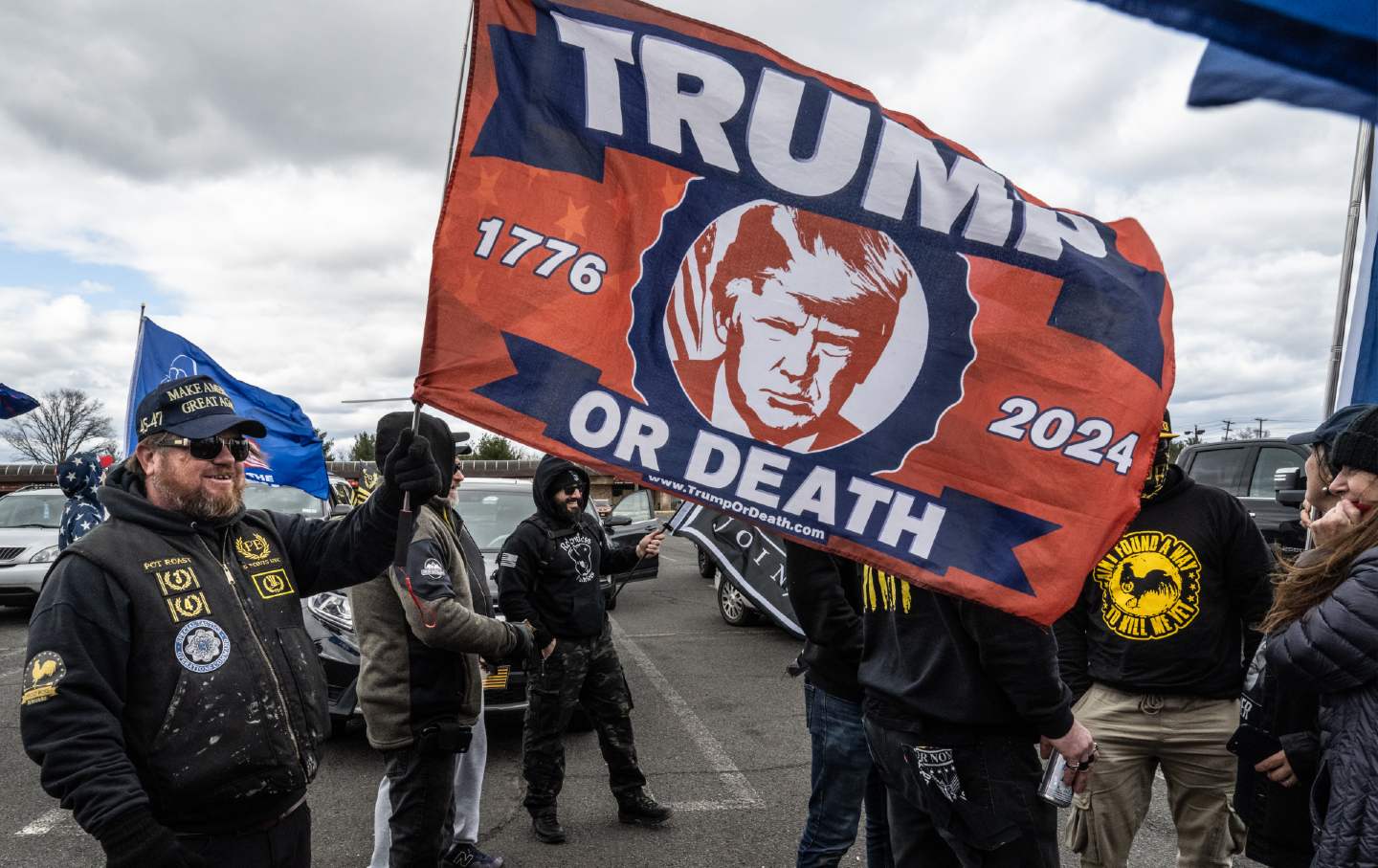
Supporters of former president Trump hold a rally on April 6, 2024, in Bedminster, New Jersey.
(Stephanie Keith / Getty Images)
On March 23, 2023, former president Donald Trump launched his third presidential bid in front of a raucous, rollicking crowd in Waco, Texas. Waco, a city of about 145,000 people in east Texas, situated halfway between Dallas and Austin, was the scene 30 years earlier of a bloody showdown between federal and state law enforcement officers and the heavily armed Branch Davidian cult, a siege that left scores of Branch Davidians dead in a suicidal conflagration. Since those events, which began on February 28 and ended on April 19, 1993, Waco has become iconic in the memory of far-right, violence-prone militia groups, and it inspired a militia-affiliated extremist, Timothy McVeigh, to explode a truck bomb in Oklahoma City exactly two years later, on April 19, 1995, that killed 168 people and injured 680.
By selecting Waco as his campaign kickoff event, Trump sent an unmistakable signal to violence-prone extremists nationwide. The Houston Chronicle, in an editorial about Trump’s rally, wrote that the choice of Waco went far beyond a “dog whistle” and compared it to “the blaring of air horn of a Mack 18-wheeler barreling down I-10,” adding that Trump was “stoking the fires of Waco.”
In his speech, Trump fed his audience the red meat that many of them were looking for. He opened the rally by playing a song, “Justice for All” by the “J6 Choir,” recorded by men imprisoned for the insurrection at the US Capitol on January 6, 2021, accompanied by footage of the mob attack. Claiming that the United States has been taken over by “Marxists and communists,” Trump said ominously, “2024 is the final battle. That’s going to be the big one.”
And he added: “I am your warrior.… I am your retribution.”
Trump, of course, has a long history of supporting and encouraging potentially violent supporters. In 2016, during his first campaign, he suggested that “the Second Amendment people”—i.e., his gun-owning backers—might be able to stop the nomination of Democratic Supreme Court choices. In 2019, he said, “I can tell you I have the support of the police, the support of the military, the support of the Bikers for Trump—I have the tough people, but they don’t play it tough—until they go to a certain point, and then it would be very bad, very bad.” And in 2020 Trump famously told the Proud Boys militia to “stand back and stand by.” Ultimately, the Proud Boys would help lead the January 6 insurrection.
Such rhetoric has led many people to warn that Trump, an authoritarian favored by white supremacists, is a fascist, or proto-fascist, and that stopping him in this year’s election is essential to prevent the erosion of democracy, end runs around the US Constitution, and the beginning of a slide toward fascism in America. But one thing that Trump doesn’t have, so far at least, is something that both Benito Mussolini and Adolf Hitler could count on in their parallel ascents to power in the early 1920s: a reliable force of street thugs and paramilitary units that he and his allies can deploy against Trump’s “enemies,” from the Democrats (“Marxists and communists”) to immigrants, racial minorities, LGBTQ organizations, and that “enemy of the people,” the media.
Certainly, Trump has summoned US militias and other extremists to his cause. In 2020, for instance, at the height of nationwide protests against lockdowns, mask requirements, and school closures at the start of the coronavirus crisis, Trump issued a series of viral tweets urging his followers to “liberate” Michigan, Minnesota, and Virginia, where armed adherents were mobilizing in street demonstrations. For instance, on April 17, 2020, Trump tweeted—characteristically, in all caps—“LIBERATE MICHIGAN!” Soon afterwards, gun-toting Trump supporters invaded the state capitol in Lansing. Most egregiously, he called on supporters to gather in Washington on January 5-6, 2021—“Be there, will be wild”—for a rally that ended in the occupation of the Capitol and led to Trump’s impeachment.
Yet so far Trump’s interaction with militia groups and what the US Department of Justice calls “domestic violent extremists” has been mostly at arms-length, and the national militia movement is leaderless and inchoate. But America is heading into an election as a bitterly divided nation in which a substantial portion of the populace believes that violence may be necessary. According to a survey by the University of Chicago’s Project on Security & Threats, as many as 14 percent of Americans say that violence is justified to “achieve political goals that I support,” and 4.4 percent—that’s more than 11 million US adults—agree that “the use of force is justified to return Donald Trump to the presidency.”
“We are in such an extremely polarized country, where more and more issues are seen as zero-sum, that we are in a tinderbox state where anything can set people off,” says Mark Pitcavage, who’s spent decades studying far-right extremists for the Anti-Defamation League, and who says that Trump’s entry in politics has politicized the militia movement. “It’s like we’re standing outside a building filled with explosives and hoping nobody’s smoking inside.”
Blackshirts and Brownshirts
Mussolini’s Blackshirts and Hitler’s Brownshirts both started small.
In the 1920s, in a Europe devastated in the aftermath of World War I, seething with resentment over the losses suffered and, especially in Germany, its humiliating defeat, ultranationalists and right-wing zealots emerged out of battles with socialists and communists. The far right was bolstered by the support of businessman, landowners, and a ruling elite that saw the growing violence of its streetfighters as a battering ram against the left.
The street force that would catapult Benito Mussolini into power started with only a few thousand men. But the would-be Italian dictator was charismatic and had an angry, alienated populace to rally to his side, many of whom were already predisposed toward violence. During Italy’s Black Years (1920–21), self-organized gangs of street thugs began taking shape in a few urban centers, under the rubric of the Fasci Italiani di Combattimento, a decentralized militia-like organization established by Mussolini. Calling themselves squadristi, many of them donned ragtag uniforms, carried rifles and revolvers, and began a pattern of systematic small-scale attacks against their political opponents on the left.
Squadrism had its first major success in the city of Ferrara, northeast of Bologna, where they crushed Ferrara’s socialists and trade unionists, smashing printing presses, invading union halls, intimidating local officials, and beating and torturing prominent leftists, and then in Bologna. As historian John Foot writes in his book, Blood and Power: The Rise and Fall of Italian Fascism, “The disintegration of local democracy in Bologna would be a model which was exported across Italy from that moment on.” Membership in the Blackshirts grew exponentially after that. Hundreds of squads formed across Italy, in units of 30 to 50 men. In 1922, 16,000 Blackshirts led the March on Rome, and Mussolini was named prime minister. “This is the violence of which I approve,” announced Mussolini. “This is the violence of Fascism.” By the end of 1922, the number of Blackshirts would rise to 200,000. Mussolini inflated those numbers a bit in his first speech to parliament, claiming the support “of 300,000 young people, armed to the teeth, ready in an almost mystical way to follow my orders.”
Meanwhile, while conditions in Germany in the early 1920s differed significantly from those in Italy, Adolf Hitler modeled his Brownshirts on Mussolini’s Blackshirts, and they served in a similar function: to unleash violence against the left. In 1923, Hitler boasted: “If a German Mussolini is given to Germany, people would fall down on their knees and worship him more than Mussolini has ever been worshipped.”
As with the Blackshirts, the Nazi Brownshirts, called the Sturmabteilung (SA), or Storm Division, was tiny at first, established by Hitler as a kind of bodyguard formation to protect Hitler’s speeches in beer halls. It drew its recruits from a pool of German rightists called the Freikorps (Free Corps), a 400,000-strong, ultra-violent paramilitary militia that engaged in mass killing of socialists and communists in the immediate aftermath of World War I. Some of its members, mostly in Munich, were recruited by Hitler into his “hall protection” squad, first called the “Gymnastic and Sports Section” and finally the SA. Initially, the beer-hall brawlers who gravitated to Hitler at his Hofbrauhaus events numbered at most a few dozen, and they engaged in brutal fights with clubs and truncheons against dissenters and protesters. By 1922, the SA had grown steadily, and its first major success came in November 1922 during “German Day” in Coburg, a town on the Itz River in Bavaria, when 800 SA storm troopers marched through the streets of Coburg carrying swastika banners and, using violence, seized effective control of the city. By March 1923, when Hitler named Hermann Göring to head the SA, it was a well-disciplined militia of just 3,000 men.
An American SA?
It’s hard not to draw a parallel between the SA’s role in protecting Hitler’s beer hall events and the emergence of the Proud Boys, the Oath Keepers, and the Three Percenters—all paramilitary-like groups—as unofficial bodyguards and security for Trump. According to Rachel Kleinfeld, a senior fellow at the Carnegie Endowment for International Peace, “The Oath Keepers provided security to Trump campaign rallies and events in Texas, Minnesota, Washington, DC, and elsewhere at regular intervals between 2016 and 2020.”
During and after Trump’s presidency, gun-toting protesters occupied several state capitols, organized militias at the US-Mexican border to combat what Trump called an “invasion,” mobilized militia-like formations to engage in street fights with antifa and the Black Lives Matter demonstrations that followed the murder of George Floyd, and created self-defined protection units to defend business owners who opposed pandemic-imposed lockdowns and closures.
Ann Coulter, who called the Proud Boys “brawny, tattooed brutes,” invited a 20-man squad of Proud Boys to protect her at a speech at UC Berkeley in 2020. And Roger Stone, the inveterate right-wing mischief maker and Trump ally who’s maintained close ties to the Proud Boys, used the Oath Keepers, another far-right militia, as a personal security detail on January 6, 2021. The Proud Boys “lined up behind Donald Trump and were willing to commit violence on his behalf,” said a federal prosecutor involved in charging those involved in the January 6 attack. “The defendants saw themselves as Trump’s army.”
The armed occupation of the Michigan state capitol in 2020 was carried out by the Michigan Liberty Militia, the Michigan Proud Boys, and others, carrying semiautomatic assault rifles (Two men arrested in that action were later charged in a plot to kidnap Governor Gretchen Whitmer.) Only 13 states have elected to regulate or restrict open carrying of weapons, making it difficult or impossible to prevent armed demonstrators from intimidating opponents. Similar armed rallies, focused on militant opposition to Covid-19 restrictions, were also held inside statehouses in Ohio, Kentucky, Pennsylvania, Indiana, and Wisconsin, and armed demonstrations erupted in the streets of Salt Lake City, Denver, Pittsburgh, and Dallas, according to a compilation by Everytown for Gun Safety. And in January 2020, the Virginia Citizens Defense League (VCDL), a militant pro-gun group, led a massive, armed march and rally in Richmond, Virginia, to protest gun safety legislation, in concert with militias and the boogaloo movement. “We welcome our militia brothers and sisters,” said the VCDL. According to the Everytown report, “Militia groups descended on Richmond [and] organized a conference the day before, titled ‘The State of the Militia’ at which various militia leaders spoke, including those who had helped plan the [Unite the Right] event in Charlottesville.”
Popular
“swipe left below to view more authors”Swipe →According to a research report by Everytown and the Armed Conflict Location and Event Data Project (ACLED), a broad-based, international research group that tracks political violence worldwide and monitors scores of militias and other actors in the United States, between January 2020 and June 2021 “at least 560 demonstrations included the presence of an armed individual, other than law enforcement.” Sixty-seven of those involved the boogaloo boys, 56 the Three Percenters, and 42 the Proud Boys.
At least 20 states have laws on the books permitting the open carrying of weapons inside the state capitol. One state that does not is Oklahoma. Don Spencer, the leader of the Oklahoma Second Amendment Foundation, complained that despite his organization’s lobbying efforts, the state legislature has blocked a bill that would allow it. “We have introduced Capitol Carry, but the Republicans”—he calls them RINOs—“kill it every time,” said Spencer, in an interview with The Nation. “All the states around us have it, Texas, Kansas, Arkansas, Missouri. We had a rally in support of Capitol Carry on the grounds of the state capitol, and a few hundred people carrying all kinds of weapons showed up.”
By one measure, since 2020 the organized militia movement and the universe of armed, right-wing anti-government groups has suffered significantly. The militia movement took a big hit in August 2020, when Facebook took unilateral action to deplatform the Proud Boys, the Oath Keepers, and the Three Percenters. “For the militia movement, this was a body blow, and a lot of the groups simply collapsed, lost track of their members, couldn’t recruit, and new groups couldn’t form,” says the ADL’s Pitcavage. At the time of the deplatforming, the Oath Keepers had 536,839 followers on Facebook, according to Everytown for Gun Safety.
Then, in the wake of January 6, a nationwide manhunt by the FBI, the arrest of scores of top leaders from the Proud Boys and the Oath Keepers, and greater attention from state and local law enforcement drove militia members, armed citizen groups, and violence-prone lone-wolf activists into hiding. Many went underground, making them harder to track, and online they formed closed groups or met mostly in person, according to the Southern Poverty Law Center. “January 6 mostly destroyed the largest one, the Oath Keepers, and it has not managed to reconstruct itself,” Pitcavage says.
But the pool of potentially violent Trump supporters is still enormous. (Those half-million Oath Keeper followers are still around.) In 2021, The New York Times, citing law enforcement analysts, reported that anywhere from 15,000 to 20,000 people belong to militias in as many as 300 groups, and that, worryingly, one-fourth of those are veterans or active-duty military personnel. The Proud Boys, virtually decapitated after January 6, reverted to local chapters. Julie Farnam, the CEO of Pandorus Intelligence LLC, is a veteran of the Homeland Security Department and before and during the January 6 insurrection she was the acting director of intelligence for the US Capitol Police, where her warnings about the coming storm went unheeded. In an interview with The Nation, Farnam said that there are at least 154 local, decentralized chapters of the Proud Boys in 48 states with a robust communications system via Telegram. “They are still hyper-aware of what Donald Trump is saying and doing,” says Farnam, who’s closely monitoring their activity.
“The movement is reverting back to a local and regional structure, but they’re still engaged in equipping their followers in tactical gear and training in the woods,” Travis McAdam, senior researcher for the SPLC, told The Nation. The SPLC currently tracks 51 organized militias, part of what it describes as “more than 1,500 hard-right extremist groups operating across the country.”
At least one recent attempt was launched this year to create a national militia under the name National American Patriot and Liberty Militia (NAPALM) and its parallel name, the National Constitutional Militia. It’s being organized by Jake Lang, currently in jail on charges of assaulting law enforcement officers with a baseball bat on January 6, along with a host of extremists and white nationalists. Recruiting online on Instagram and X, the militia claims to have enlisted 25,000 people, but according to Wired its ranks are more like 2,500. But it drew a bizarre endorsement video on X from Patrick Byrne, the multimillionaire Trump supporter and former CEO of Overstock.com: “It’s time we form up militias, well-organized militias, ideally that we umbrella out to help maintain law and order,” said Byrne. “There’s a wonderful organization started by Jake Lang but supported by hundreds of sheriffs and many of the big names in the liberty movement…and it’s called NAPALM.”
What’s especially worrisome is that conservative elected officials, sheriffs, and Republican Party offices are tacitly, and sometimes even explicitly, cooperating with, encouraging and supporting militia groups. The membrane that has long separated the state and local governments from nongovernmental and private ultra-right actors, including violence-prone ones, is becoming increasingly porous.
Rachel Kleinfeld is a senior fellow at the Carnegie Endowment for International Peace’s Democracy, Conflict, and Governance Program and an expert on political violence. In an interview with NPR’s On Point and in an essay for Just Security called “The GOP’s Militia Problem,” Kleinfeld said that militias in many parts of the country are going mainstream. “So what we’re seeing is in Republican counties, often local officials, occasionally state level, we’re starting to see a willingness to work with militias,” she said. Members of local chapters of the Proud Boys have muscled into GOP organizations from Miami to Kansas, North Carolina, central California, and Oregon, running for office, backing candidates, and taking over local party organizations. The chairman of the Wyoming GOP, Frank Eathorne, is a former member of the Oath Keepers.
In a recent report, ACLED emphasized the role of official toleration of militias in allowing them to prosper: “The lack of open sanctions on these groups from public figures and select local law enforcement has allowed them space to operate while concurrently allowing public figures to claim little direct responsibility for violent actions from which they hope to benefit.”
“It would be foolish to underestimate the power of Trump’s comments to call rogue militias to action,” wrote Mary McCord, in essay for Lawfare five years ago. “The militia movement has shown that it will take action based on the president’s statements.”
Coming 15 months before the January 6 insurrection, McCord’s words were prophetic. Since then, McCord has emerged as Paul Revere–like figure as the executive director of the Institute for Constitutional Advocacy and Protection (ICAP) at Georgetown Law School. A former acting assistant US attorney general for national security, McCord was appointed by Speaker Nancy Pelosi as legal counsel to the US House task force charged with investigating the events of January 6. And ICAP has since engaged in a whirlwind of legal briefs, model legislation, and warning letters to states and localities about militia-like activities, along with detailed research about the threat posed by radical anti-government groups.
In an interview with The Nation, McCord says that she has documented a kind of “call-and-response, dog-whistle” pattern that allowed Trump to summon armed support groups to his cause, and that his insistence that the 2020 election was rigged has created a dangerous climate for 2024. “If he doesn’t win, he’s been planting the seeds of a false narrative that people with AR-15s are listening to,” she says. “A lot of what happens is up to Trump and what words he uses, and to what extent does he call people to engage in violence.”
McCord stresses that despite the Second Amendment, which refers to a “well-regulated militia,” militias and militia-like organizations are illegal in all 50 states. In the landmark 2008 Supreme Court case District of Columbia v. Heller, in which the court supported the most conservative interpretation of the Second Amendment and gun ownership, Justice Antonin Scalia also wrote that that amendment “does not prevent the prohibition of private paramilitary groups.” Yet, says McCord, laws against militias are never enforced, partly because local officials misinterpret the law, partly because militias thinly disguise their activities, and partly because many local law enforcement agencies are broadly sympathetic.
“Private militias continue to recruit, train, and deploy largely unimpeded,” said McCord, in testimony to a House subcommittee. “This is so even when they openly acknowledge their intent to serve as an armed counterforce to what they view as tyrannical government action.”
“Constitutional Sheriffs” and the NRA
Providing the background music for the militia movement and a wide range of other extreme right, anti-government groups is the granddaddy of them all, the National Rifle Association. Though in recent years the far right has been moved to action over the immigrant “invasion,” Covid-19 restrictions, and election fraud conspiracies, no other issue galvanizes the right more than gun safety measures and fears that Democrats are scheming to disarm gun owners.
And at the local level, in parallel with the NRA itself, a group calling itself the Constitutional Sheriffs and Peace Officers Association (CSPOA) has emerged to unite elected government officials—that is, the nation’s 3,000 elected sheriffs, one in each of America’s 3,000 counties—and pro-militia armed citizens. Founded in 2011 by Richard Mack, then sheriff of Graham County, Arizona, CSPOA claims that in each country the sheriff is “sovereign,” and can exert law enforcement powers that exceed both federal and state authorities—and includes the refusal to enforce federal and state gun laws. Though its membership rolls are secret, at least 69 sheriffs have been identified as CSPOA members, and in a survey conducted by the Arizona Center for Investigating Reporting, 200 of the 500 sheriffs surveyed said that they agreed with CSPOA’s ideology. Its current CEO, Sam Bushman, operates Liberty News Radio, a forum for white nationalists, where Bushman has hosted Stewart Rhodes, the Oath Keepers’ founder, multiple times. (Rhodes is currently serving an 18-year sentence for his role in the January 6 insurrection.)
Mack, its founder, was a former member of the Oath Keepers board of directors, and since leaving that post he’s maintained ties with the Oath Keepers and other parts of the militia movement. The CSPOA encourages its members to enlist local armed citizens in what they call a “posse,” essentially a sheriff-sponsored militia that can be called up, say, to confront protesters or riots. Sheriff Bob Songer of Klickitat County, Washington, for instance, a CSPOA board member, claims to have assembled a posse of 150 men, after telling the feds to “stay out of our county.” Songer, a far-right personality with a wide following, has worked with a pro-militia organization called Patriot Prayer, which is closely tied to the Proud Boys.
What’s especially worrisome about CSPOA and its member sheriffs’ efforts, like Songer’s, to recruit local civilians to posses is that provides a connection point between the militia movement and local governments. According to Georgetown’s McCord, CSPOA has “advocated for county recognition of local militias.” And in one recent case, in Nassau County, Long Island, just outside New York City, a pro-Trump county executive and the local sheriff made news recently when the executive, Bruce Blakeman, placed an ad asking for local gun-license holders to sign up to be deputized as a civilian law enforcement adjunct force. The priority, he said, would be for ex-military and former law enforcement personnel, who’d earn $150 per day for their participation. In an interview with WPIX-TV, Blakeman said that the force could be called up “if there was a riot.”
In a petition on Change.org, local opposition groups condemned the recruitment scheme which, the petition said, “has all the earmarks of a MAGA militia.” Sabine Margolis, a local activist who initiated the petition, told The Nation in an interview that 2,000 people, more than 90 percent of whom are locals, have signed it so far. Despite her efforts, Blakeman and the local sheriff have ignored the protests, and she said that “they’re still recruiting, they’re still training.” Margolis added: “I’m German. This stinks to high heaven. It’s just like Germany in the 1930s. He’s playing with the dictator playbook.”
Like the sheriffs’ organization, the NRA has had ties to the militia movement, and one of its former board members, right-wing rocker Ted Nugent, was a vocal defender of the Michigan Militia. “Leaders of the Oath Keepers have also appeared at NRA events,” said an Everytown report. “The NRA holds its annual Great American Outdoor Show, an expo for hunters, in Harrisburg, Pennsylvania. At every show between 2014 and 2018, the Pennsylvania chapter of the Oath Keepers had a booth at the event.”
Not surprisingly, in 2024 the NRA has given Trump its endorsement. Of course, after a decade of controversy, financial troubles, and high-profile lawsuits against it, the NRA has lost a significant about of its clout. Still, the organization, once topping 6 million members, can still boast of 4.2 million, and will spend millions of dollars in the 2024 election. On February 9, Trump appeared at the NRA’s Great American Outdoor Show in Harrisburg, Pennsylvania, telling the crowd, “They are coming to get your guns,” and announcing the creation of Gun Owners for Trump. And on May 18, Trump traveled to the NRA’s annual convention in Dallas, Texas, where he predicted “death and destruction like never before” if he isn’t elected in November.
Whether Trump could and whether he intends to rally armed right-wing extremists on his behalf—especially were he to lose the election in November—is something that is unknowable. But the very fact that it’s conceivable does indeed invoke the specter of It Can’t Happen Here.

